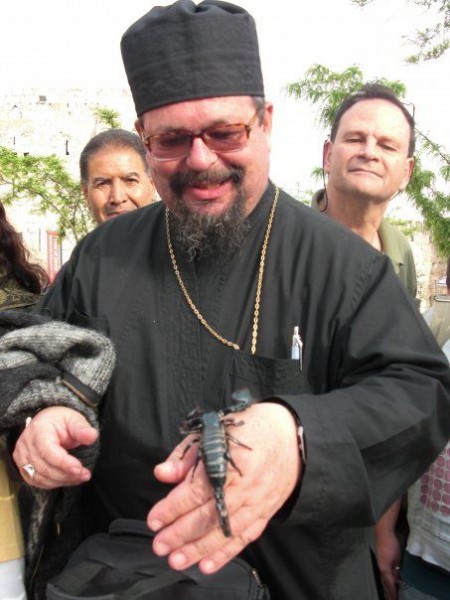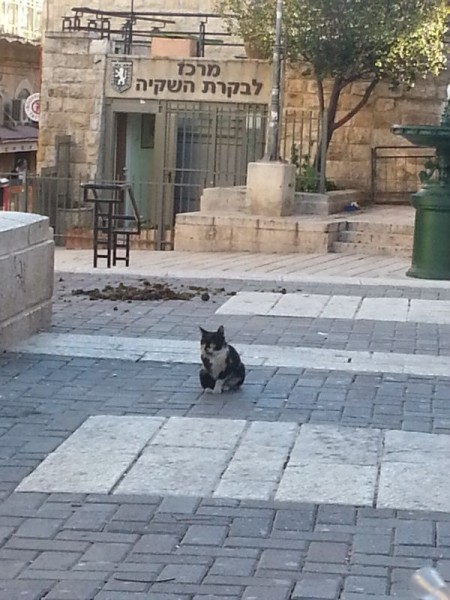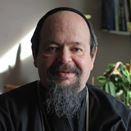L’été arrive et les animaux auront soif, par A. Winogradsky Frenkel
[In "Tribune Juive"]
"http://www.tribunejuive.info/opinions/lete-arrive-et-les-animaux-auront-soif"
Il
commence à faire chaud. La météorologie israélienne est un service
fondamental, national, collectif, démocratique social et économique.
Tant de choses dépendent de ces degrés qui vont s’affirmer dans
l’ensemble du pays.
Ce n’est pas toujours évident : il fait toujours un peu frais dans
les maisons aux murs épais de la Vieille Ville de Jérusalem. La
population est naturellement frileuse. A 12°-15° Celsius, la situation
prend une allure hivernale. Cela dépend des saisons, mais, en général,
nous sommes plutôt habitués à la chaleur du jour. Abraham tenait tente
ouverte dans le désert, enfin! une tente !? C’était plutôt une sorte de
grand drap tendu qui protégeait du vent, du sable, des intempéries : un
espace ouvert à tout ce qui pouvait passer : « (Abraham) était assis à
l’entrée de sa tente au plus chaud du jour/ אבהם ישב בפתח-אהל כחום-היום
(Bereishit/Gén. 18, 1-2) ».
Est-ce indécent ? L’israélien est volontiers décontracté, genre
baba-cool à l’allure de sabra dur-tendre attendrissant ; on passe du
T-shirt délavé à des costumes un peu « provinciaux ». Les femmes
s’habillent de la même façon, mais les shorts laissant les cuisses
apparentes avancent à la même cadence nonchalante que les femmes
ultra-orthodoxes dont les longues jupes noires cachent du soleil et des
assauts cancérigènes de la lumière trop crue.

Un ami reptile lors d’une exposition à la Porte de Jaffa sur comment fréquenter sans crainte ces petites bestioles
Certains hommes portent kippot, yarmoulkes (kippa style turc et Asie
centrale), d’aucun ajoute en sus un chtreimel fait de sept queues de
vison… La Pologne s’appellait « Eretz K’naan/ארץ כנען-Terre de Canaan »
en yiddish où le hassid se devait de porter la même coiffe que les
nobles ruthènes ou polonais… Cela semblerait un peu chaud, selon la
saison, même à Jérusalem ou dans les déserts. Pourtant !… Me rendant
régulièrement dans le Néguev, j’ai rencontré, voici quelques années,
deux femmes à Beer-Shéva : l’une en manteau de fourrure (eh oui!) par
42° Celsius, l’autre menait un chien – à moins que l’animal ne
conduisait sa maîtresse – à poils longs qui avançait paisiblement en direction d'Arad.
La femme à la fourrure était originaire de l’Union Soviétique et
m’expliqua naturellement qu’elle avait froid par cette température
étouffante, comme si la pelisse animale la réchauffait d’avoir quitté le
froid, lui prodiguant la douceur d’une nostalgie en forme de mirage.
Quant au grand chien de compagnie, il marchait à longues enjambées comme
sa compagne plutôt vêtue de trois fois rien. En fait, ses poils
s’avéraient protecteurs et régulateur de la température ambiante…. et il
buvait beaucoup m’assurait Madame.
L’ETE EST PROCHE :
PENSEZ À VOS ANIMAUX DE COMPAGNIE
C’est lancé ! Je reçois toutes sortes de messages d’alerte ! « L’été
est proche, pensez à vos animaux de compagnie ! » -telle est la mitzvah
des mois à venir : veiller à ce que nos « petits compagnons » ne
souffrent pas de la chaleur ou de l’ombre, voire d’un froid artificiel
par air conditionné, le mazgan\מזגן national. Il s’agit de cette
tendresse naturelle pour l’être animal qui a souvent plus de
discernement que l’humain : bon, le serpent n’est peut-être pas un bon
exemple encore que l’on passe du conseil tordu et mal-intentionné envers
Eve au salut dans le désert lorsque le serpent d’airain est élevé
devant le peuple (VaYikra/Nombres 21, 6–9). Le corbeau a indiqué à Noé
que la voie de terre était libre; d’autres sont venus raviver le moral
défaillant du prophète Elie (1 Rois 17).
Il y a surtout l’ânesse du faux prophète Bilaam qui fit chuter le
fonctionnaire dont la mission était de maudire le peuple juif. Dans sa
culbute, il se convertit, se retourna et de la haine exprima la beauté
des tentes de Jacob, des demeures d’Israël. C’est ainsi que
Cha’harit/שחרית, l’office du matin commence par les parole d’un impie
retourné par une monture qui le tança vertement : « Que Tes tentes sont
belles, Jacob, Tes demeures, Israël ! »
Animal de compagnie ? Voici quarante ans, il y avait peu de chiens et
de chats en Israël. Ou bien, ils étaient discrètement présents-cachés.
Il n’est pas fortuit que la Bible hébraïque ne fait aucune mention des
« chats », divinités païennes, idolâtriques de l’Egypte ancienne. Il y a
bien un chat-tigre, dit « shunra/שונרא » dans le Talmud (‘Hullin 53a),
mais avec grande modération. Il oscille entre le mauvais présage et la
joie chantante (shoura\שורא) des destinées personnelles.
De nos jours, nous avons acculturé toutes les bestioles de la
création, non que l’alerte concerne le très beau zoo biblique de
Jérusalem. De même, il n’est pas question de nos vaches honteusement
exploitées comme bêtes « Lumpenproletariat » pour fournir un lait
indispensable à notre survie.
A la tombée du jour, on voit sortir toutes sortes d’animaux : chiens
poils courts, quasi une raie sur le côté, tatoués, policés, brossés, en
laisse encore que… A Tel Aviv, sur le Yarkon, le tableau est hédoniste
et dans les Mashbir et autres supermarchés le « pet-food » devient une
denrée élaborée, au fond « post-soixante-septarde ».
A Jérusalem, voici qu’à 5 h (17 h. selon l’usage européen) de jeunes
huskies sortent suivis de gamins arabes qui courent derrière eux,
fébriles de voir s’ébrouer des espèces d’apparence plus nordique. D’autres
sortent aussi avec quelques oiseaux de compagnie pour flâner à la
fraîche – les moineaux, quant à eux, se rassasient de pain, de
pitot/פיתות amicalement placées sur des rebords de murailles, le
‘hobez,
le pain arabe.
AU SEUIL D’UN PRINTEMPS
QUI TOURNE VITE A L’ ÉTÉ
Chaque année, la même vigilance est ravivée au seuil d’un printemps
qui tourne vite à l’été. Il faut prendre soin des animaux, appelez-les
« bêtes » ou « bestiaux ». Mais surtout, il y une frénésie à donner à
manger et à boire aux chats. Ceux-ci pullulent un peu partout dans les
grandes villes jusqu’à ce qu’un conseil municipal décide de les ramasser
et de les faire passer de vie à trépas. C’est un problème réel pour
beaucoup de municipalités et cet assassinat annuel a provoqué de
nombreuses protestations.
Il reste cependant du temps pour prendre soin de ces compagnon(ne)s,
voire de les sauver en les faisant adopter. Une manière de leur assurer
une « aliyah » intérieure domestique.
Il y va, en premier lieu – à ce qu’il paraîtrait – d’un respect
envers le monde animal : les créatures animales nous ont précédé dans
l’ordre de la création et nous leur sommes liés autant par un héritage
physique, culturel – du poisson au gorille, orang-outan (« homme des
bois » en indonésien) – que le génome et l’ADN sont venus confirmer.
La tradition juive demande que, dans une maisonnée, on commence par
nourrir les animaux avant de se rassasier soi-même (Berakhot 40a).
L’être humain a non seulement le discernement « du ventre », il sait
normalement où et comment se procurer de la nourriture. Ce n’est pas le
cas de l’animal domestiqué ou les animaux d’élevage, le bétail qui
deviendra rentable pour l’homme ou l’assiste dans sa production. Ils ne
savent pas comment trouver leur pitance. Les choses sont évidemment
différentes pour les animaux sauvages, encore que le Talmud interdise de
les affamer (Bava Metzia 2, 5, Shabbat 151b).
On trouvera toujours dans les parcs publics d’Israël des personnes
des deux sexes qui viennent chaque jour nourrir les oiseaux, voire
d’autre animaux dans certaines régions et, bien sûr, les chiens et chats
sans colliers. Réflexe atavique d’"Araméens vagabonds" ? De survivants de
toutes sortes de famines ? Le Proche-Orient a une mémoire vive de temps
de grandes disettes, de guerres où les champs comme le bétail, le
mépris de l’être vivant comprend aussi ces sous-créatures que sont nos
compagnons d’existence. La désertification comme la technique de la
terre brûlée ont souvent exterminé des animaux sinon des espèces.
Tout doit conduire au respect conscient de la vie et il faut tout
faire pour interdire que les animaux soient traités avec cruauté (Tsa’ar
ba’alei ‘hayyim/ צער בעלי חיים = (interdiction de faire souffrir les
créatures vivantes de manière cruelle, Chmot/Ex. 23, 5 et Shabbat 128b,
Bava Metsia 32b), de manière volontaire ou involontaire.
Mais entrons plus avant dans ce mouvement généralisé au seuil de
l’été qui consiste à assurer un service « Premiers Soins » auprès des
chiens et chats égarés dans les rues. Il existe, dans chaque ville
israélienne, une antenne de l’Association « des chats de rue de…
(Jérusalem, Haifa, Tel Aviv…\ עמוטה למען חתולי רחוב….). On écrit
beaucoup sur la Shoah, on spécule sur sa philosophie. Il y a d’abord
l’expérience grégaire, primale alors qu’on se hâte d’enregistrer les
témoignages d’humains encore doués de paroles et pouvant faire des
récits qui seront analysés dans les générations à venir.
ASSOCIATION DES CHATS DE RUE
DE JÉRUSALEM

Isolé en plein Jérusalem-centre
Pour bien comprendre le sens de la destruction semblable au Temple
vivant, le Khourban-Khirb’n\חורבן en hébreu et en yiddish que fut la
Catastrophe (grec, russe), l’Holocauste, le Génocide et la Shoah, il
faut assister, ne fût-ce qu’une fois, sans gêner personne, à une réunion
de l’Association des Chats de Rue, par exemple de Jérusalem. Dans cette
ville, les tragédies de l’extermination s’y expriment comme en miroir
de l’avilissement, la famine, les blessures infligées aux animaux.
La douleur la plus intense, comme intériorisée, s’exprime dans ces
groupes d’assistance publique à des animaux qui, d’une certaine façon,
apparaissent et disparaissent sans que nul ne se soucie vraiment d’eux.
La comparaison avec le temps de la Shoah est alors évidente, avec les
aléas de l’histoire qui se déroule souvent comme « à l’aveuglette »
envers le peuple juif comme à l’encontre des nations « vagabondes et
sans statuts ». Le parallèle avec la Shoah est puissant, même s’il reste
caché, difficile à approcher. Encore faut-il faire le lien entre la
survie de citoyens déchirés dans leur âme et leur mémoire et l’abandon
de petites bêtes qui risquent quotidiennement leurs vies par manque de
soins, comme proies faciles pour les accidents de la circulation, sinon
les désirs sadiques à faire le mal sans raison apparente.
Je passe mon temps à bénir les animaux de nos rues, où que je sois –
essentiellement des chats proche-orientaux à la tête souvent
triangulaire. Et à donner du pain bénit aux oiseaux : une sorte d’amour
réel et réaliste envers les reptiles, les gazelles, les mangoustes ou
autres. C’est une très ancienne pratique de la foi dans la région. La
tradition russe orthodoxe est sensible à l’amour des bêtes, comme saint
Séraphim de Sarov vivant à côté de son ours et partageant son miel. Il
est l’héritier de la tradition monastique du désert de Judée où saint
Gérasimos vivait paisiblement avec les lions et toute une ménagerie près
du Jourdain.
Le lien avec saint François d’Assise s’impose : il ne
s’agit pas d’un comportement bêtifiant, hip-hop, allumé ou déconnecté.
Il y va de sentiments profondément inscrits au tréfonds de la vraie
conscience humaine vivant au rythme d’un équilibre humain. Il s’agit de
cette quête prophétique où l’ours cohabite avec l’agneau (Isaïe 11, 7),
mais aussi de la paix intérieure de l’hésychasme de l’Orient byzantin,
cette paix globale que proposa Rabbi Nahman de Breslav dans son Tikun
Klali/תוקון כללי. La louve a nourri Rome-ROMA dont le mot (inversé)
désigne précisément l’AMOR, cette joie à vivre et non à détruire. By
Jove, que devient donc le monstre reptile du Loch Ness qui a cessé de se
montrer pour la première fois depuis 99 ans ?
FAIRE CUIRE UN ANIMAL
DANS LE LAIT DE SA MÈRE
En fait, qu’y a-t-il à nourrir cette compagnie zoologique ? Sans
doute ce sens inné de la « famille », de la michpakha-michpoukhe\משפחה
judéo-yiddish. Les « mishpakhtonim\,משפחטונים » (garderies d’enfants)
fleurissent un peu partout, comme dans le monde entier. Ils ont pour but
d’assurer la garde et l’éveil des petits. Les associations pour la
protection des animaux jouent le même rôle, un peu comme des antennes
mobiles. Vers le mois de mai, on trouve des jeunes gens et des jeunes
filles qui parcourent les rues d’Israël avec des bouteilles d’eau, de
lait et des pâtées pour faire sereinement ronronner ces bêtes SDF avec
patte de velours.
Tout est question de survie, de protéger ce qui est en vie. Tuer un
petit animal est aussi amoral que d’assassiner un être humain, causant
une souffrance toujours latente dans l’existence mais qu’il nous faut
apprendre à éviter, supprimer, guérir (Guide des Perplexes 3, 48).
Telle est la raison apparemment irrationnelle de l’interdiction de
faire cuire la viande d’un animal dans le lait de sa mère (Chmot/Ex.
23,19-Devarim/Deut. 14, 21). En soi, il est évident que la mère de
l’animal n’a aucun moyen de savoir ou même comprendre que son petit est
cuit dans « son lait maternel » : il est viscéralement nourricier et non
assassin. Pourtant, c’est là que se trouve l’injonction faite au peuple
juif et aux croyants de ne pas dériver vers une « cruauté gratuite et
collective ». La mitzva ne met pas l’accent sur le fait de tuer et
manger des animaux consommables (Bereishit/Gén. 9, 3).
Dans une société souvent sauvage, inhumaine ou déshumanisée, ce
commandement vient rappeler que tout meurtre est contre-nature en raison
de ce précepte selon lequel il est illégitime de tuer, exterminer,
anéantir en utilisant le suc de la fertilité, de la vie, de la
croissance, de l’être [le lait de la mère]. Un contre-sens de la
civilisation.
Tel est le témoignage de Noé : peu enclin à s’inquiéter de ses frères
humains, avant ou après le déluge, il a clairement dû s’occuper de ses
amis les bêtes, par paires et pour un temps long.
Il y a une corrélation puissante entre le sentiment vif d’être des
rescapés, voire en danger d’extermination ou de persécution et l’aide
apportée aux animaux des villes d’Israël.
Merci d’en tenir compte si vous visitez le pays ou si vous y habitez
sans vraiment avoir conscience de ces drames : vous pensez qu’il n’y a
pas un chat… regardez bien et soyez un vrai « pet friend ».
 Av Aleksandr Winogradsky Frenkel
(Patriarcat de Jérusalem)
https://sites.google.com/site/hebrewinchurch/
Av Aleksandr Winogradsky Frenkel
(Patriarcat de Jérusalem)
https://sites.google.com/site/hebrewinchurch/
 Tudo bom
Tudo bom נחת
נחת מיר האבן געכאפט א סך שמועס
מיר האבן געכאפט א סך שמועס

 Av Aleksandr Winogradsky Frenkel
Av Aleksandr Winogradsky Frenkel














































